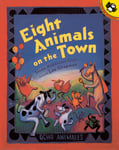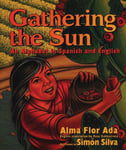Booksource has collections of Spanish poetry books for the primary grades and the upper elementary grades. Kyle Warren is offering one lucky I Teach Dual Language reader a five book sampling from both collections!




Here's how to enter for a chance to win:
In their efforts to serve bilingual teachers even better, the Warren Instructional Network would like to know, how important to you is the use of authentic (versus translated) Spanish language materials in your daily literacy instruction?
Leave a comment below with your answer and you will receive one entry in the drawing. Want a bonus entry? "Like" I Teach Dual Language on Facebook and leave a comment here that you did.
Anonymous entries cannot win because that makes announcing the winner very difficult! The giveaway will close at 8 pm CST on Friday, June 8th and a randomly drawn winner will be announced by 9 pm.
I actually teach English learners in an English only school, but I incorporate their home language as often as possible. I see how they are losing their home language, which saddens me. They love when we read bilingual books, and it always starts a fun discussion with lots of smiles and laughter. We also write our own bilingual books and responses. Next year, my goal is to acquire more bilingual books to send home with students to read with their parents. In this way, I really hope to encourage home language maintenance and literacy.
ReplyDeleteNatalie, that is wonderful that you are advocating for your students by still providing some native language support! Good luck in building your library!
DeleteI think having authentic Spanish books makes a difference in their comprehension and reading. Many times when they are translated, as a teacher I find myself explaining the reading, explaining certain words or what they meant to say and that rarely happens with authentic Spanish books. That said, there are a few translators who do a wonderful job of not just translating literally but making the translation relevant to native Spanish speakers even with the use of rhyming. One example: Dr. Seuss' The Cat in the Hat in Spanish has no rhyming becuase he just translated everything directly to Spanish while with the The Cat in the Hat Comes Back has the rhyming of the English book and maintains Dr. Seuss' style.
ReplyDeleteI haven't compared these two books you mentioned but I recently read Hay un molillo en mi bolsillo and was really impressed with the translation. The translator for that book and The Cat in the Hat Comes Back is Yanitzia Canetti. Her translations seem to be really good! She also translated ¡Qué locura por la lectura! by Judy Sierra. Translating like that is truly a gift!
DeleteY. Canetti does a great job indeed with her translation. I have a set of about 20 Dr. Seuss books in Spanish and they all have Dr.Seuss' rhyming style except for the Cat in the Hat. My son(3 yrs) loves his books and even has MANY lines memorized. I had already written in this blog before but had not visited lately. Thank you for all the helpful information you gave us yesterday.
Deletelroque@dallasisd.org
You're welcome! I remember your name from earlier visits. I wish we could have chatted more on Tuesday! I hope you enjoy lots of rhyming time with that 3 year old boy this summer! He sounds very smart! :)
DeleteI'm going to start my first teaching job in Phoenix next year, and my new school is 85% Hispanic. It's really important to me to use authentic texts because it makes the comprehension and understanding so much easier for students. When texts are translated, sometimes the meanings don't translate over or the words just aren't quite right, which takes away from the book. I would love to have these books!
ReplyDeleteLiz
langhoff.elizabeth@gmail.com
I also liked I Teach Dual Language on Facebook!
ReplyDeleteLiz
langhoff.elizabeth@gmail.com
I have taught bilingual second grade and next year will teach a bilingual 1/2 classroom. I greatly prefer authentic Spanish literature. Reading it is so much more natural than trying to figure out what the translator was trying to say in inauthentic translations to Spanish. The language is much more natural and helps expose the students to quality Spanish.
ReplyDeleteMrs. Castro
Mrs. Castro's Class 2nd Grade...Spanglish Style
And I follow you on Facebook!
ReplyDeleteMrs. Castro
Mrs. Castro's Class 2nd Grade...Spanglish Style
These books would be great in my classroom library. I also just liked the FB page!!
ReplyDeleteAuthentic Spanish literature is so much easier to read and for studnts to understand. I read the translated version of Dr. suess's The Lorax and WOW.... It was difficult to read! Candis i attended your breakout session "Hasta Manana Iguana" and i just wnted to thank you for all the great ideas! I will definitely be incorporating those into my classroom. These books would also be a great addition to my classroom library! Thanks again!
ReplyDeleteThank you, Vanessa! I hope you have a wonderful summer!
DeleteI also liked you on facebook :)
ReplyDeleteLike many have already mentioned if the text is not authentic or poorly translated it is hard to comprehend and at times it does not make sense. In some cases the translations use vocabulary terms that students and sometimes teachers have never seen before.
ReplyDeleteMrs.G
www.2ndadventureswithmrsg.blogspot.com
I liked you on FaceBook.
ReplyDeleteMrs.G
www.2ndadventureswithmrsg.blogspot.com
Hola!
ReplyDeletePara empezar ya le puse el "Like" en facebook.
Para mi es sumamente importante trabajar con libros que sean autenticamente traduciones y bien traducidos. Ya que me ha tocado trabajar con algunos que no estan bien traducidos y muchas veces los ninos/as no entienden las palabras que tienen. Es importante ya que permite una mejor compresion por parte de los ninos/as ya que usa palabras que ellos conocen. Ademas es mas facil para uno como maestro al leerlo, uno no tiene que estar traduciendo en el momento y tratando de reemplazar la palabra por otra mas facil de entender.
Ojala se acuerde de mi! La conoci el martes en Bryan Adams, en la platica de rimas y me acerque a usted para preguntarle sobre mi caso. Ya ordene el libro de Reading Magic, estoy esperando que llegue con mucha ansiedad a ver si encuentro las respuestas a mis problemitas con mis estudiantes. Gracias de nuevo por el detalle y por tan buena charla. Nos vemos pronto.
Delete¡Claro que sí! Espero que le guste el libro de Reading Magic. Aunque no tenga todas las respuestas a sus problemas, espero que le confirme de lo que es importante y lo que no es tan importante para los chiquitos que apenas están comenzando a leer y escribir. ¡Mándeme un mensaje cuando lo termines!
DeleteConsidero que es mucho mejor leer libros no traducidos pues a menudo en los libros traducidos se encuentran traducciones cuasi literales que no dan sentido al texto que se maneja al leer en español. Si estamos enseñando a leer y escribir en español deberíamos evitar que los estudiantes trabajen con material "defectuoso".
ReplyDelete